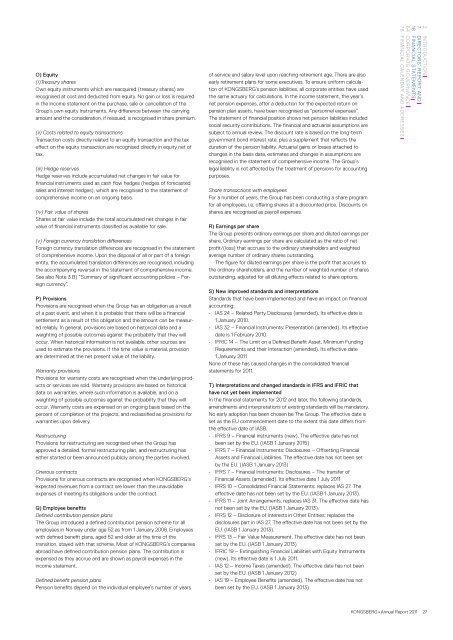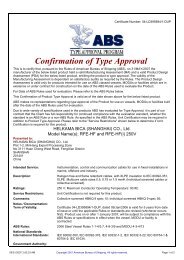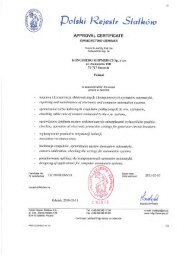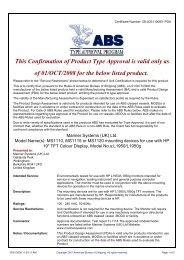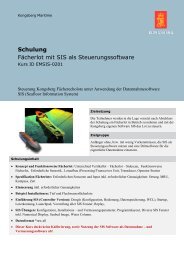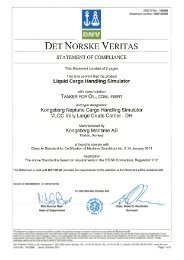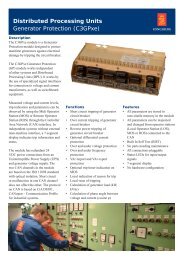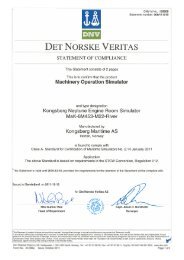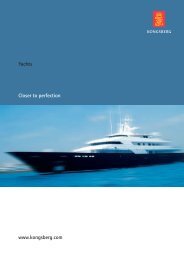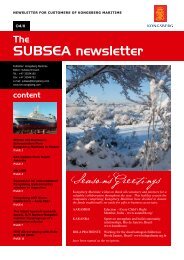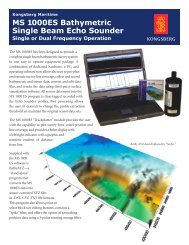Annual Report 2011 - Kongsberg Maritime - Kongsberg Gruppen
Annual Report 2011 - Kongsberg Maritime - Kongsberg Gruppen
Annual Report 2011 - Kongsberg Maritime - Kongsberg Gruppen
You also want an ePaper? Increase the reach of your titles
YUMPU automatically turns print PDFs into web optimized ePapers that Google loves.
O) Equity<br />
(i)Treasury shares<br />
Own equity instruments which are reacquired (treasury shares) are<br />
re cognised at cost and deducted from equity. No gain or loss is required<br />
in the income statement on the purchase, sale or cancellation of the<br />
Group’s own equity instruments. Any difference between the carrying<br />
amount and the consideration, if reissued, is recognised in share premium.<br />
(ii) Costs related to equity transactions<br />
Transaction costs directly related to an equity transaction and the tax<br />
effect on the equity transaction are recognised directly in equity net of<br />
tax.<br />
(iii) Hedge reserves<br />
Hedge reserves include accumulated net changes in fair value for<br />
financial instruments used as cash flow hedges (hedges of forecasted<br />
sales and interest hedges), which are recognised to the statement of<br />
comprehensive income on an ongoing basis.<br />
(iv) Fair value of shares<br />
Shares at fair value include the total accumulated net changes in fair<br />
value of financial instruments classified as available for sale.<br />
(v) Foreign currency translation differences<br />
Foreign currency translation differences are recognised in the statement<br />
of comprehensive income. Upon the disposal of all or part of a foreign<br />
entity, the accumulated translation differences are recognised, including<br />
the accompanying reversal in the statement of comprehensive income.<br />
See also Note 3 B) “Summary of significant accounting policies – Foreign<br />
currency”.<br />
P) Provisions<br />
Provisions are recognised when the Group has an obligation as a result<br />
of a past event, and when it is probable that there will be a financial<br />
settlement as a result of this obligation and the amount can be measured<br />
reliably. In general, provisions are based on historical data and a<br />
weighting of possible outcomes against the probability that they will<br />
occur. When historical information is not available, other sources are<br />
used to estimate the provisions. If the time value is material, provision<br />
are determined at the net present value of the liability.<br />
Warranty provisions<br />
Provisions for warranty costs are recognised when the underlying products<br />
or services are sold. Warranty provisions are based on historical<br />
data on warranties, where such information is available, and on a<br />
weighting of possible outcomes against the probability that they will<br />
occur. Warranty costs are expensed on an ongoing basis based on the<br />
percent of completion of the projects, and reclassified as provisions for<br />
warranties upon delivery.<br />
Restructuring<br />
Provisions for restructuring are recognised when the Group has<br />
approved a detailed, formal restructuring plan, and restructuring has<br />
either started or been announced publicly among the parties involved.<br />
Onerous contracts<br />
Provisions for onerous contracts are recognised when KONGSBERG’s<br />
expected revenues from a contract are lower than the unavoidable<br />
expenses of meeting its obligations under the contract.<br />
Q) Employee benefits<br />
Defined contribution pension plans<br />
The Group introduced a defined contribution pension scheme for all<br />
employees in Norway under age 52 as from 1 January 2008. Employees<br />
with defined benefit plans, aged 52 and older at the time of the<br />
transition, stayed with that scheme. Most of KONGSBERG’s companies<br />
abroad have defined contribution pension plans. The contribution is<br />
expensed as they accrue and are shown as payroll expenses in the<br />
income statement.<br />
Defined benefit pension plans<br />
Pension benefits depend on the individual employee’s number of years<br />
of service and salary level upon reaching retirement age. There are also<br />
early retirement plans for some executives. To ensure uniform calculation<br />
of KONGSBERG’s pension liabilities, all corporate entities have used<br />
the same actuary for calculations. In the income statement, the year’s<br />
net pension expenses, after a deduction for the expected return on<br />
pen sion plan assets, have been recognised as “personnel expenses”.<br />
The statement of financial position shows net pension liabilities included<br />
social security contributions. The financial and actuarial assumptions are<br />
subject to annual review. The discount rate is based on the long-term<br />
government bond interest rate, plus a supplement that reflects the<br />
duration of the pension liability. Actuarial gains or losses attached to<br />
changes in the basis data, estimates and changes in assumptions are<br />
recognised in the statement of comprehensive income. The Group’s<br />
legal liability is not affected by the treatment of pensions for accounting<br />
purposes.<br />
Share transactions with employees<br />
For a number of years, the Group has been conducting a share program<br />
for all employees, i.e. offering shares at a discounted price. Discounts on<br />
shares are recognised as payroll expenses.<br />
R) Earnings per share<br />
The Group presents ordinary earnings per share and diluted earnings per<br />
share. Ordinary earnings per share are calculated as the ratio of net<br />
profit/(loss) that accrues to the ordinary shareholders and weighted<br />
average number of ordinary shares outstanding.<br />
The figure for diluted earnings per share is the profit that accrues to<br />
the ordinary shareholders, and the number of weighted number of shares<br />
outstanding, adjusted for all diluting effects related to share options.<br />
S) New improved standards and interpretations<br />
Standards that have been implemented and have an impact on financial<br />
accounting:<br />
• IAS 24 – Related Party Disclosures (amended). Its effective date is<br />
1 January 2010.<br />
• IAS 32 – Financial Instruments: Presentation (amended). Its effective<br />
date is 1 February 2010.<br />
• IFRIC 14 – The Limit on a Defined Benefit Asset, Minimum Funding<br />
Requirements and their Interaction (amended). Its effective date<br />
1 January <strong>2011</strong><br />
None of these has caused changes in the consolidated financial<br />
statements for <strong>2011</strong>.<br />
T) Interpretations and changed standards in IFRS and IFRIC that<br />
have not yet been implemented<br />
In the financial statements for 2012 and later, the following standards,<br />
amendments and interpretations of existing standards will be mandatory.<br />
No early adoption has been chosen be The Group. The effective date is<br />
set as the EU commencement date to the extent this date differs from<br />
the effective date of IASB.<br />
• IFRS 9 – Financial instruments (new). The effective date has not<br />
been set by the EU. (IASB 1 January 2015)<br />
• IFRS 7 – Financial Instruments: Disclosures – Offsetting Financial<br />
Assets and Financial Liabilities. The effective date has not been set<br />
by the EU. (IASB 1 January 2013)<br />
• IFRS 7 – Financial Instruments: Disclosures – The transfer of<br />
Financial Assets (amended). Its effective date 1 July <strong>2011</strong><br />
• IFRS 10 – Consolidated Financial Statements: replaces IAS 27. The<br />
effective date has not been set by the EU. (IASB 1 January 2013).<br />
• IFRS 11 – Joint Arrangements: replaces IAS 31. The effective date has<br />
not been set by the EU. (IASB 1 January 2013).<br />
• IFRS 12 – Disclosure of Interests in Other Entities: replaces the<br />
disclosures part in IAS 27. The effective date has not been set by the<br />
EU. (IASB 1 January 2013).<br />
• IFRS 13 – Fair Value Measurement. The effective date has not been<br />
set by the EU. (IASB 1 January 2013)<br />
• IFRIC 19 – Extinguishing Financial Liabilities with Equity Instruments<br />
(new). Its effective date is 1 July <strong>2011</strong>.<br />
• IAS 12 – Income Taxes (amended). The effective date has not been<br />
set by the EU. (IASB 1 January 2012)<br />
• IAS 19 – Employee Benefits (amended). The effective date has not<br />
been set by the EU. (IASB 1 January 2013)<br />
2 INTRODUCTION<br />
7 DIRECTORS’ REPORT AND<br />
18 FINANCIAL STATEMENTS<br />
64 CORPORATE GOVERNANCE<br />
76 FINANCIAL CALENDAR AND ADDRESSES<br />
KONGSBERG <strong>Annual</strong> <strong>Report</strong> <strong>2011</strong> 27


